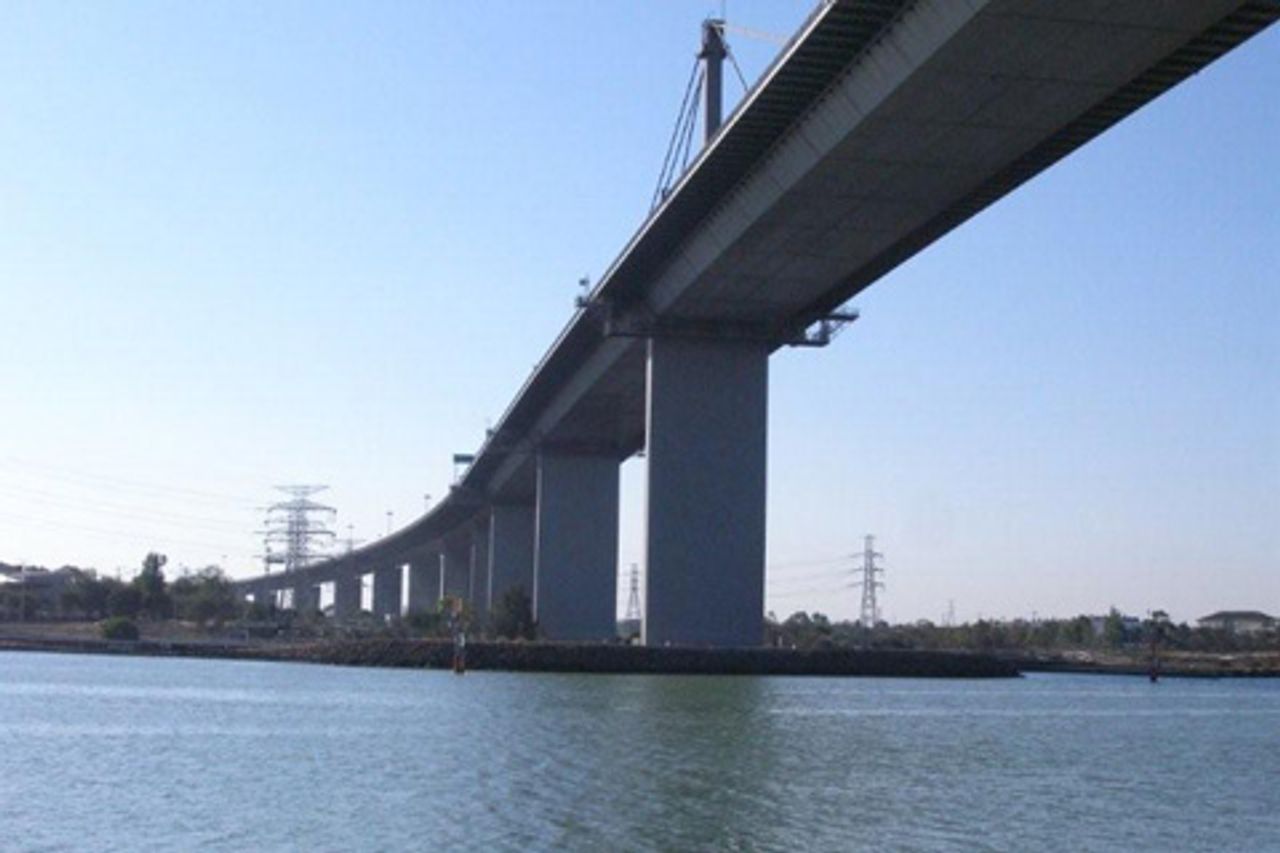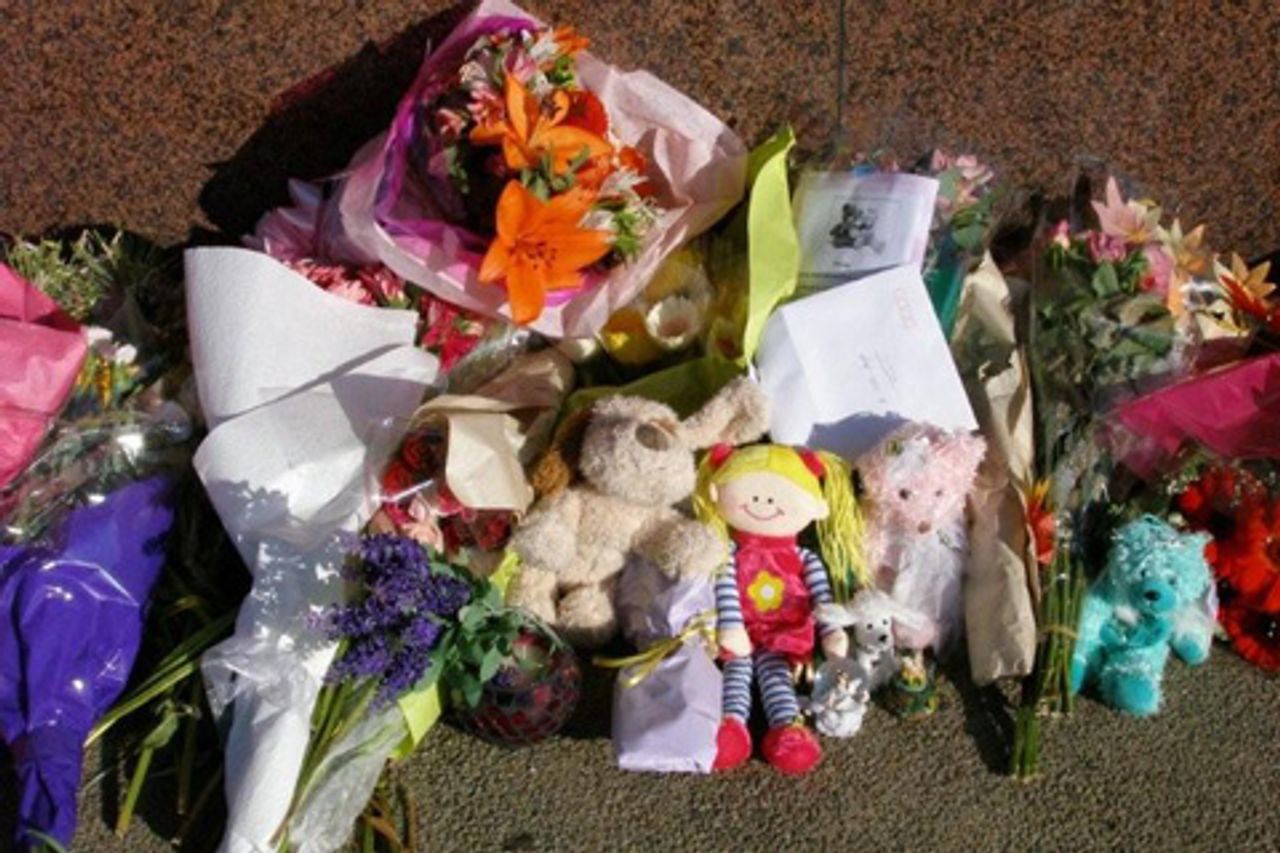At about 9.10 a.m. on January 29 and in the midst of an unprecedented summer heat wave, Arthur Freeman, a 35-year-old father of three, drove onto Melbourne's busy West Gate Bridge, allegedly took his 4-year-old daughter, Darcey, from the car and dropped her from the bridge. The young girl's two brothers—Ben, aged six, and Jack, aged two—were in the car and witnessed the entire incident.
Darcey plunged 58 metres—the equivalent height of a 17-storey building—into the Yarra River, a major shipping lane, and died of massive internal injuries four hours later in the Royal Children's Hospital with her mother by her side.
Freeman and his three children had been travelling back to Melbourne during the morning rush hour, after spending the night at his parents' home in a small coastal town about 120 kilometres from the Victorian state capital. This was to be Darcey's first day at primary school.
 West Gate Bridge
West Gate BridgeEyewitnesses later said that they noticed a white Toyota Landcruiser in the emergency lane at the top of the bridge. A man had walked to the back door of the car, taken a young girl in his arms, walked toward the bridge railing and dropped her over the edge.
According to one media outlet, a female witness leapt out of her car and ran shouting at Freeman after he dropped the little girl. The report suggested that the woman's actions may have averted the tragic death of the entire family.
Freeman allegedly jumped in his car and quickly left the scene.
The horrified witnesses immediately called police and emergency services, and within minutes the girl was pulled unconscious from the river. Paramedics worked to save her life for 50 minutes before she was flown to hospital.
A short time later Freeman arrived at the Commonwealth law courts in Melbourne's CBD. He was shaking uncontrollably, weeping and pacing up and down. His two boys were clinging to him and he apparently approached the security staff asking them to "take my kids for me". Worried staff called paramedics and police for assistance.
Police officers arrived and Freeman was charged with murder. A doctor later told the magistrates court that the 35-year-old was psychologically unfit for interview. He was remanded in custody, placed on "suicide watch" and will reappear in court on May 21.
The day before the tragic incident, Freeman and his estranged wife, Petra Freeman, had appeared in the Family Court. Freeman wanted greater access to his children and the couple are believed to have reached a compromise. Lawyer Zelma Rudstein, who represented Freeman in the family law case, told the media after his arrest that he was a "very devoted father" and that there had been "no signs" that such a horrific event might occur.
Sensationalist response from sections of the media
The Herald Sun, Rupert Murdoch's Melbourne tabloid, responded to the event with its usual mixture of sensationalist, superficial and deeply-insensitive reportage.
The privacy and legal rights of Freeman, his wife and their two boys were ignored as the paper led with a full front-page unpixalated photo of the distraught father and a massive headline, "HOW COULD HE?" This was followed by pages of photographs identifying all the family members, the apartment block where Freeman lived, and the name and address of the school that the children attended. The report included a half-page photo of the children's bikes, stroller and toys in Freeman's backyard.
No attempt was made to probe the underlying and complex conditions of life that could lead a father to carry out such shocking actions. The newspaper, instead, attempted to whip up a lynch-mob type atmosphere, appealing to base instincts and the most disoriented sections of the population.
While there were some who responded with calls for a return of capital punishment, these were a small minority. The overwhelming response expressed deeply-felt sympathy for all concerned.
Within hours of the tragedy hitting the headlines scores of Internet social networking pages sprang up about Darcey's death. In less than a week 150,000 people had joined Facebook groups organised to honour the little girl's memory, with thousands of messages and heart-felt support for the family from around the world.
Some social networking sites called for donations to assist the family, while others began organising events to remember Darcey, including the release of pink balloons on the day of her funeral, petitions to the family court and a national memorial day.
 The base of the West Gate Bridge soon became a makeshift memorial, with scores of flowers, candles, cards, angels and teddy bears dedicated to the four-year-old. Many of the gifts were located near a memorial commemorating 35 workers who died when part of the bridge collapsed during its construction in 1970.
The base of the West Gate Bridge soon became a makeshift memorial, with scores of flowers, candles, cards, angels and teddy bears dedicated to the four-year-old. Many of the gifts were located near a memorial commemorating 35 workers who died when part of the bridge collapsed during its construction in 1970.
A few days later, Melbourne truck driver Simon Smith announced that a convoy of trucks and utilities would drive over West Gate Bridge on Valentine's Day, February 14, in memory of Darcey. Those participating would each be asked to contribute $20 toward a special fund, with half the money going to Darcey's family for counselling and other needs and the remainder to promote a mental health program in Victorian schools.
"We support families in need," Smith told the media. "We are basically all family men. This is something that hit home with all of us."
Grappling for answers
This outpouring has been accompanied by countless messages explaining the impact of the young girl's death on workplaces and communities. Some have attempted to understand what produced the young girl's death and what could be done to prevent future similar tragedies.
Many letters to newspapers and Internet sites, particularly from Australia, have denounced the Victorian state government for failing to place barriers on the West Gate Bridge. Approximately 20 people per year commit suicide by jumping off the bridge and last year a woman and her 18-month-year old boy were found dead at its base.
Some comments suggested that barriers would only be a "band-aid", and would not resolve the underlying problem. They pointed to the epidemic growth in mental illness in recent years and the criminal lack of resources. Others wondered how many more families would be "pushed to breaking point" with escalating "job losses and fear of losing everything".
Rick Whelan from Melbourne, for example, wrote: "Our mental health system rivals the rubbish US mental health system which is appalling. What do you have if you don't have your health... this includes mental health, as 1 in 4 will suffer a mental illness in this country and that is only the reported illnesses.
"I wonder how many people thought to themselves, ‘how close have I been to doing something equally horrific?'... [A] very scary question and I bet the country would be in shock if such answers could be collected," Whelan wrote.
Crisis Support services chief executive Wendy Sturgess cautioned those attempting to demonise Freeman. "How horrific the circumstances must have been for him to do what he did," she said.
Sturgess also explained that Mensline Australia, a help-line for fathers suffering family breakdown, which generally receives 150 calls per day, had seen a spike in phone calls following Darcey's death. "We've had many calls," she said, from "around the country from men saying, ‘I know what it's like to be so much in pain that that's the only way I can think, to end my life or to end my children's lives'."
Beginning in 2000, and in the midst of a skyrocketing divorce rate, a series of high profile murder-suicides occurred in Australia—among them a family-law campaigner and a federal government politician. After intense lobbying, the former Howard government made a series of changes to family law in 2006, established family relationship centres and advocated what was regarded as a less adversarial approach to custody disputes.
These modifications, which emphasised the concept of "equal shared family responsibility", however, were entirely inadequate and did little to alleviate the problems.
Last week, Jennifer McIntosh, a clinical psychologist involved in high-conflict divorce cases, told the media that screening methods to detect potentially homicidal and violent parents involved in custody disputes were "primitive".
This was further underlined in a statement issued on February 5 by Darcey's family. The brief statement thanked all those, in Australia and internationally, who had supported the family, but declared that they felt let down by the state authorities.
"For the past two years," the statement said, "the various authorities have been made aware of our fear for the safety of the children and unfortunately no one would listen. We feel the judicial system that failed our family and will continue to fail other families until someone in authority starts to take action."
While we do not know the exact circumstances that precipitated Freeman's actions, they are part of a growing international phenomenon. Three days before Darcey plunged to her death, for example, a distraught 40-year-old Los Angeles father killed his wife and their five children in a horrendous murder-suicide after both parents had lost their jobs.
It is no mystery why families and relationships break down in the present environment of financial insecurity, social tensions and pressures on ordinary working people to deal individually, with virtually no social assistance, with the growing complexities of daily life. Rather than probing the roots of these escalating social problems, the political and media establishment simply washes its collective hands and blames "flawed" or "evil" individuals.
Recent research indicates that fathers living without their children are five times more prone to commit suicide than those who live with them. A hand-written note found in Freeman's apartment after the tragedy, confirmed that he was deeply troubled by the family court hearing. In the note, he referred to "keeping a clear head" and that he had "a big fight on his hands and by no stretch of the imagination would it be easy".
It appears that for Freeman, the loss of his family, the separation from his children, combined with his inability to cope with other emotional and psychological pressures and the lack of timely diagnosis and treatment, proved a toxic mix that exploded in a total loss of control—and the killing of his only daughter.
Suggested further reading:
Murder-suicide in Southern California leaves seven family members dead
Another murder-suicide in Australia
